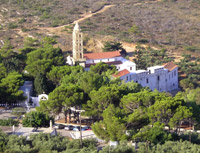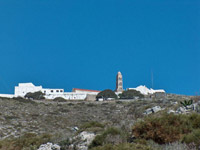|
|
Kythira Island Area: 282 sq
km (109 sq
mi)
Population: 3.500
 The island
of Kithera located in the Mediterranean Sea 14 nautical miles
off Kavo Maleas on the south-eastern most tip of the
Peloponnese between Crete and Peloponesse, with name Kithera
or Cerigo. Ships dock at Agia Pelagia near a beautiful stretch
of coastline and bathing beach. The capital, Kythera, 30km (19
miles) south, is easily reached on the main roadway which
crosses the island. It is a neat hamlet, built on a hillside
overlooking the sea, which is crowned by a Venetian castle.
Kapsali is the main harbour. Mostly rocky with many
streams, it produces wine, goat cheese, olives, corn, and
flax. On the south shore is Kithira (1971 pop. 349), the chief
village, formerly called Kapsali. Ancient Kithira was a center
of the cult of Aphrodite. The island passed to Greece in 1864. The island
of Kithera located in the Mediterranean Sea 14 nautical miles
off Kavo Maleas on the south-eastern most tip of the
Peloponnese between Crete and Peloponesse, with name Kithera
or Cerigo. Ships dock at Agia Pelagia near a beautiful stretch
of coastline and bathing beach. The capital, Kythera, 30km (19
miles) south, is easily reached on the main roadway which
crosses the island. It is a neat hamlet, built on a hillside
overlooking the sea, which is crowned by a Venetian castle.
Kapsali is the main harbour. Mostly rocky with many
streams, it produces wine, goat cheese, olives, corn, and
flax. On the south shore is Kithira (1971 pop. 349), the chief
village, formerly called Kapsali. Ancient Kithira was a center
of the cult of Aphrodite. The island passed to Greece in 1864.
A Voyage to
Kithera means to many people a nostalgic wandering in exotic
and dreamt places, just like in Wattaeu's romantic painting
The
Embarkment for the Island of Kythera (L'
Embarquement pour l' ile de Kythere). The myth of Kythera,
also known as the island of love, goes far back in the
traditions of France and Italy. Voyage to Kythera, a difficult
task, an island to which pilgrims set out but never succeed in
arriving. As long as it stays far, preserves its distant spark
as a land of eternal destination, impossible dream and ideal
beauty. Since ancient times Kithera is related to the myth of
Aphrodite, the goddess of beauty and Eros. There it lies in
her heavenly haze as a land as much utopic as well real and
within reach.
Reality
brings us to a place of myth, not so distant as it is
presented in the tradition of literature, but with its marks
strong. It is enough to walk on the clear beaches and watch
the sunset, for this to be felt. Somewhere there, the sky
meets the sea painting it with its scarlet reflections and
perhaps someone could witness the birth of Aphrodite, daughter
of Uranus and Sea. One might even see a piece of the never
ending Sky (Uranus) fall, due to the mighty slash from Cronos,
in the life-giving Sea, who wraps it with her froth. Perhaps
one could also feel the distinct breeze of Zephyros, who
rendered Aphrodite to the world and prepared her to take her
place in the mighty mythological Olympus.
 Cretes,
Phoenicians, Hellenes, Romans, Byzantines, Venetians, French,
British, they all took part in the creation of the island's
tradition, building a social, economical and cultural
originality, which balances the hellenic tradition with the
western influence in a harmonic wholeness. A totality that
contains past and present, the roughness of nature and
the
stillness of human structure, the abandonment of whole
villages in a quest for better luck in the big cities or even
abroad, mostly in Australia, and the nostalgia and the will
for homecoming after confronting privation and suffer. Today
still one can hear the air blow through the empty houses that
used to be full of life, being witnesses of a different era. Cretes,
Phoenicians, Hellenes, Romans, Byzantines, Venetians, French,
British, they all took part in the creation of the island's
tradition, building a social, economical and cultural
originality, which balances the hellenic tradition with the
western influence in a harmonic wholeness. A totality that
contains past and present, the roughness of nature and
the
stillness of human structure, the abandonment of whole
villages in a quest for better luck in the big cities or even
abroad, mostly in Australia, and the nostalgia and the will
for homecoming after confronting privation and suffer. Today
still one can hear the air blow through the empty houses that
used to be full of life, being witnesses of a different era.
As the sun
brakes out of the mist dissolves the mist - provenza, as it is
called on the island - and clears the sky in modern Kythera,
one can feel the struggle for going on. While the island's
economy progressively heads towards tourism and efforts are
made for developing appropriate infrastructure, it is obvious
that a new era lies in front of us. |